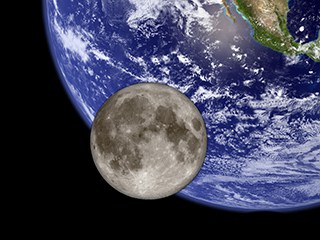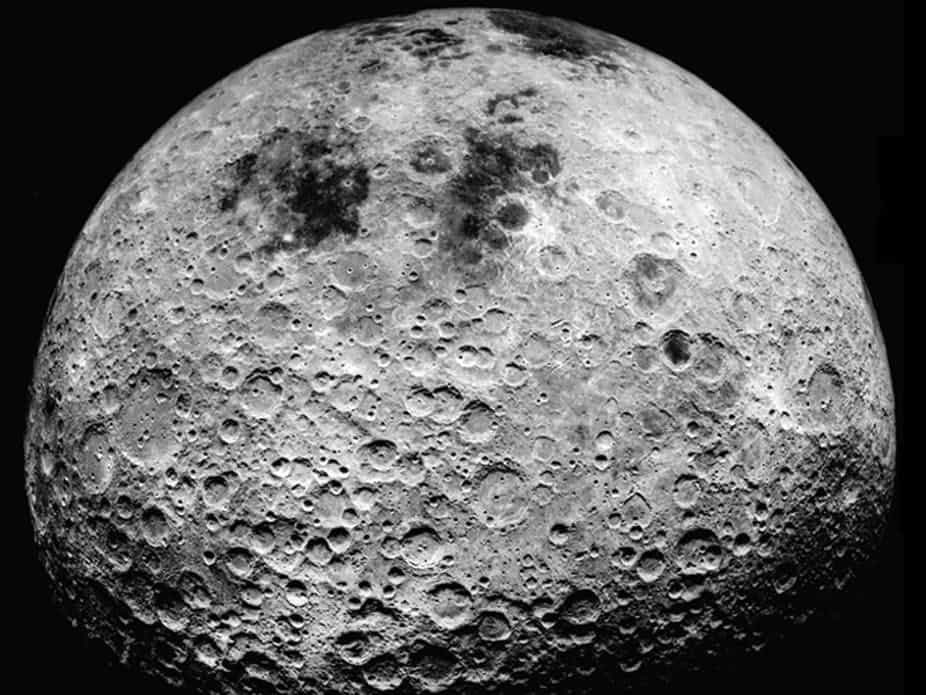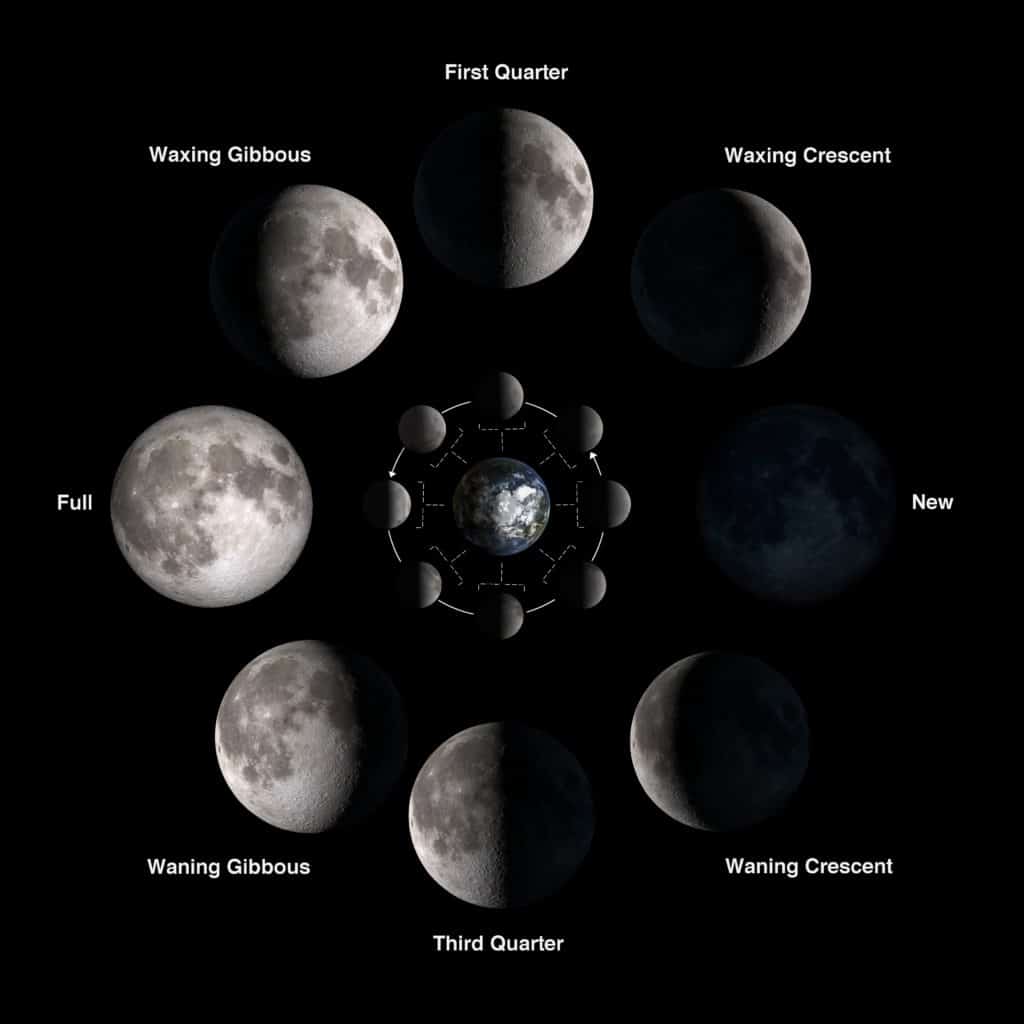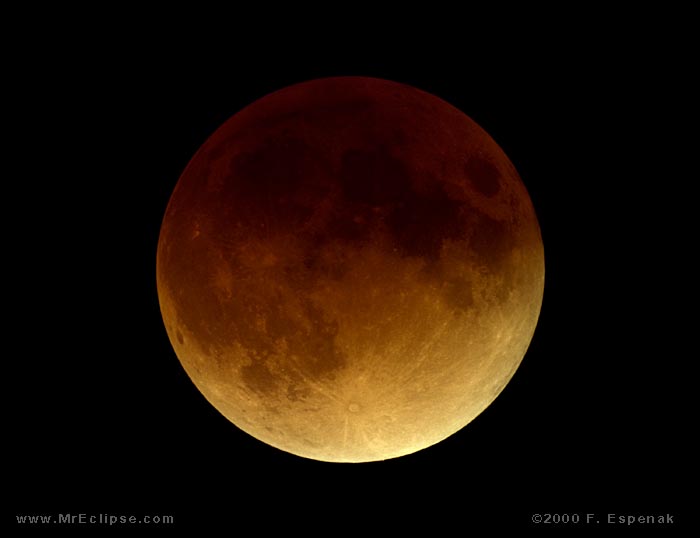The Moon is the only natural satellite of our planet, Earth. It has many different names, for example, the Romans called it Luna, Selene, and Artemis was the name given to it by the Greeks. Throughout many mythologies, the Moon has been given countless names.
Key Facts & Summary
- The Moon was created around 4.6 billion years ago. It is widely accepted that it formed when Earth suffered a collision with a planet-sized object named Theia.
- The Moon is the fifth largest satellite in the Solar System, and it is the second-brightest object in the sky after the Sun.
- The Moon has a radius of 1.737 kilometers / 1.079 miles and a diameter of 3.474 km / 2.158 mi.
- It is only at 384.400 km / 238.855 mi away from Earth.
- The Moon orbits the Earth once every 27 days.
- The tallest mountain on the Moon is Mons Huygens. It is 4.700 meters tall, around half the size of Mt Everest – the highest mountain on Earth.
- The Moon rotates on its axis around the same length of time it takes to orbit the Earth. This means that from Earth we only ever see around 60% of the Moon’s surface.
- The side of the Moon that can be seen from Earth is called the near side, while the other side is called the far side – it is sometimes referred to as the dark side.
- The first landing of an unmanned spacecraft on the Moon was conducted by Russia’s Luna program. This happened in 1966.
- The USA’s NASA Apollo 11 mission in 1969 was the first manned Moon landing.
- The first person to set foot on the Moon was Neil Armstrong.
- The far side / dark side of the Moon looks very different due to its lack of maria – ancient pools of solidified lava.
- The surface of the Moon is covered in huge craters – created from the impacts of comets and asteroids that have collided with the surface over time.
- The Earth’s tides are largely caused by the gravitational pull of the Moon.
The Moon is the second brightest object in the sky after the Sun. It is Earth’s only natural satellite. A natural satellite is a space body that orbits a planet, a planet-like object, or an asteroid. In 1959, the Moon was first visited by the Soviet spacecraft named Luna 2.

It was the first time an extraterrestrial body was visited by a man-made object. Later, in 1972, America was the first country to send a manned crew upon another celestial body in the sky.
Many samples were returned from the Moon, and they are studied to this day. In 1994, the spacecraft Clementine extensively mapped the Moon.
In total, 382 kg of rock samples were returned to Earth by the Apollo and Luna programs. They provided detailed knowledge about the Moon.

Surface and Structure
There are two primary types of terrain on the Moon. The first is the heavily cratered terrain and the very old highlands. This indicates that the Moon isn’t geologically active.
The second terrain is relatively smooth and younger, called the “maria”. The maria are the large dark spots that are present on the Moon. These dark spots once had lava seeped into them billions of years ago.
Fun Facts
- Many believe that there are small amounts of water on the Moon.
- During the day, the Moon is very hot, but also, it is very cold at night. The average surface temperatures on the Moon are at 107 degrees Celsius during the day, and – 153 degrees Celsius at night.
- A lunar eclipse occurs when the Earth is between the Sun and the Moon.
- The effects of gravity are about one fifth or 17% on the Moon compared to that on Earth.
- The Moon is Earth’s natural satellite, but there may be others as well. Certain asteroids get caught up by the Earth’s atmosphere and become satellites.
- The Moon is shaped like an egg.
- The Moon isn’t completely geologically dead. There are moonquakes and they are thought to be caused by the gravitational pull of Earth.
- The Moon is bigger than Pluto, and this pops up the question, is the Moon a dwarf planet?
- Each year the Moon steals some of Earth’s rotational energy. This propels the Moon, it makes it move away from us.

Scientists believe that the Moon formed very early in the history of the Solar System after a giant body collided with Earth, and because of this, chunk’s of Earth flew in space but later became the Moon due to the effects of gravity that pulled them together.
The Moon is also covered with dust and debris from comets. It acts as a shield in a way, protecting Earth.
Trivia
Common Misconceptions
Our Moon doesn’t actually shine with its own light. It merely reflects the light coming from the Sun. From Earth, the Moon may seem like its changing shape each night – from a tiny silver to a half moon to a full moon – But what actually happens? Well, from our spot on Earth, we see different parts of the Moon that are lit up by the Sun as the Moon travels in its orbit.

There is no dark side of the Moon. It is true that we only see one side of its surface from our position on Earth, and this is the misconception. The more accurate name for that part of the Moon is the far side.
What happens during a lunar eclipse?
Our Moon becomes dark or even becomes a bit reddish in appearance for a short time. This happens when the Moon passes through the Earth’s shadow.

The reddish-copper coloration comes from the sunlight being deflected through the Earth’s atmosphere. Factors such as the levels of pollution on Earth may affect how red the Moon appears.
The Moon changes phases on a regular cycle. It takes about 29 days for a cycle to be completed. The Moon goes through four main stages:
- First-quarter – 1 week
- Full Moon – 2nd week
- Third-quarter – 3rd week
- New Moon – 4th week
Other Characteristics
The Moon has almost no atmosphere and only about one-sixth of Earth’s gravity. There are places on the Moon where water is present but frozen, tucked away in craters near the Moon’s poles.

The gravitational forces between the Earth and the Moon cause events such as ocean tides to occur. The Moon has volcanoes, but they are currently dormant.
Moon Notes
- The Moon is the only natural satellite of Earth , and scientists believe it was formed after our planet suffered a collision with another big celestial body. Chunks of Earth flew into space, but gravity pulled them together , and thus, the Moon was born.
- The Moon has been visited a single time by a manned crew – the Apollo 11 crew.
- Rocks brought back from the Moon seem to be between 4.6 to 3 billion years old. These samples are still studied to this day.
- The Moon orbits around the Earth as fast as a rifle bullet.
- The Moon has been visited by over 100 space probes.
- The Moon is the second brightest object in the sky after the Sun.
Sources:
[1.] NASA
[2.] Wikipedia
Image sources:
- https://solarsystem.nasa.gov/system/basic_html_elements/11490_emoon_480x360_moonsbydest.jpg
- https://moon.nasa.gov/internal_resources/24/
- https://www.nasa.gov/images/content/521685main_022111a.jpg
- https://solarsystem.nasa.gov/system/resources/detail_files/676_moon_phases.jpg
- https://www.nasa.gov/images/content/187106main_eclipse_img1_full.jpg
- https://apod.nasa.gov/apod/image/1610/PenumbralLunarEclipse_Lee_2233.jpg
